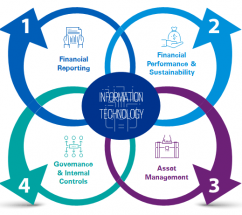
As councils grapple with infrastructure decay, optimising asset management through an ‘interconnected’ approach is more important than ever.
- This is the second in a series of articles by Ben Smith on the ‘interconnected council.’ A recent article highlighted the ‘interconnected’ nature of the challenges facing councils revealed by the Auditor General and the need for a joint response. The next instalment, to be published in January, will focus on financial performance and sustainability.
Local councils own ageing asset portfolios, with every failure under increased scrutiny from customers and state government.
New cloud-based technologies are emerging, bringing both solutions and threats, such as cyber security.
Changing workforce culture, operating models and legacy business processes can leave councils slow to react, working in silos, duplicating efforts, with reluctance to change.
However, doing nothing to improve asset management practices will ultimately result in increased customer dissatisfaction, potentially followed by intervention from regulators.
In NSW alone, 10 high risk issues across NSW councils were identified in the recent NSW Auditor General’s report for issues with the accuracy of asset registers, restricted assets and asset revaluations.
Our broader experience working with local councils across Australia shows that most councils have multiple asset registers stored in disparate spreadsheets (and sometimes none at all!). Solving the fundamental asset management challenge of balancing cost, risk and performance remains a people-intensive task.

Asset backlogs as risks
This represents a significant risk to a local council on many ‘interconnected’ fronts including difficulty in establishing a clear understanding of what assets are actually owned, across all asset classes of infrastructure, property, plant and equipment.
Accurate financial planning to ensure sufficient budget is allocated to current and future maintenance activities also remains a challenge.
This is complicated by the fact that clear governance and process for prioritising and allocating limited available funds to each asset is difficult to establish. Finally, the ability for a council to maintain its assets in safe and effective working condition for the general public is compromised.
Good asset management relies on strong governance and controls for the operating model and supporting processes, strong financial performance and sustainability that allocates sufficient budget, all supported by a suitable technology solution that establishes a single source of truth and clear asset management strategies and plans.
Improving capability
Optimising management of a council’s physical asset portfolios, as well as new and existing infrastructure is a key influence on the quality of financial reporting. Therefore, transitioning to leading practice strategic asset management will dramatically improve the quality of a council’s financial reporting.
An integrated approach to managing assets across financial and non-financial asset lifecycle functions needs to be adopted for asset management to be optimised.
- Plan, select, build and operate assets with confidence.
Conduct probabilistic capex modelling, cost peer review, project scheduling, quantitative risk analysis, cost and schedule contingency determination and risk based asset management.
- Prepare a solid foundation and build value upon it.
Develop a capital investment and prioritisation framework. Establish a clear Asset Management framework is in place and adopted. Perform asset lifecycle analysis.
- Treat your data as an asset and leverage that asset to be disruptive.
Only capture data that informs decisions. Understand Master Data Management to make that data asset reliable, validated and aligned. Implement a suitable solution and data platform to enable data driven decisions.
- Unleash the real value of your assets.
Use the solid foundation established to manage control and transparency of asset value, remaining life and residual value. Work collaboratively with Finance to focus on more effective strategic, long term financial and asset life cycle planning.
Four key tips for change
Transforming council’s asset management to meet modern challenges requires a systematic re-think of organisational strategies based on four key behaviours.
- Establish a sound foundation – implement a right-sized asset management framework to enable coordinated decision making with an interconnected asset register in place and up to date.
- Unlock operational efficiencies with technology – implement process optimisation and automation available in the latest cloud based asset management technology to free up your workforce to focus on areas of strategic value and continuous improvement.
- However technology is not a panacea – focus on your people, from operating model and governance through to maintaining skill levels appropriate to enable your people transition and excel.
- Evolve from managing assets to owning intelligent assets – assess how the hype around digitisation, artificial intelligence and the ‘Internet of Things’ (IoT) can help pave the way for smarter, faster and more robust asset related decisions.
Julian Watts is Director, Engineering & Asset Management, KPMG and Ben Smith is Director, KPMG Enterprise.
Comment below to have your say on this story.
If you have a news story or tip-off, get in touch at editorial@governmentnews.com.au.
Sign up to the Government News newsletter.